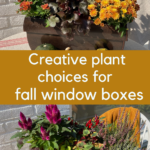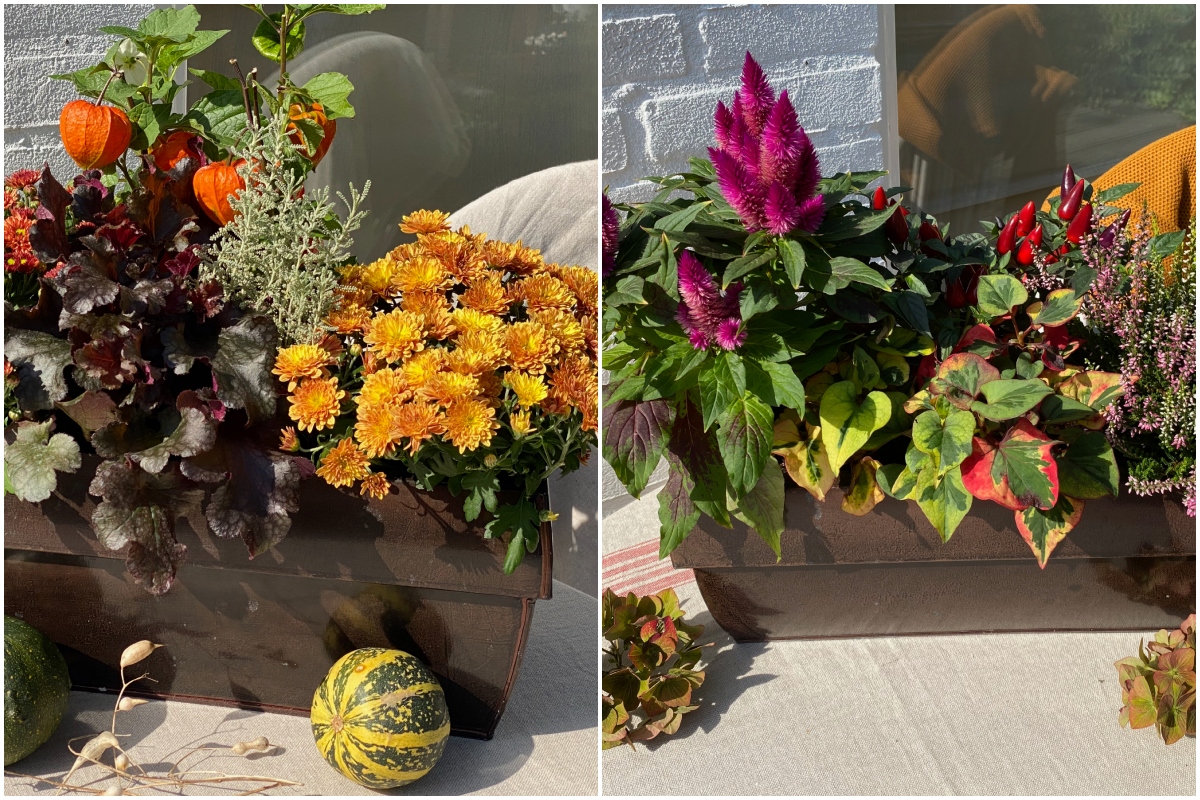
As summer is winding down, I’m once again thinking about container gardening. With a steady supply of flowers, berries, herbs and tomatoes throughout the summer months, I must admit I didn’t give container gardening much thought. I didn’t need to. All the pots on my deck have been ticking along splendidly from late May onwards.
However, just like the garden beds and borders, this time of year the containers are also starting to look a bit faded. Faded can be beautiful, but as we’re racing towards the fall equinox, my eyes are craving rustic rich colors and textures. Planting a couple of fall window boxes will satisfy this craving without too much hassle or work.
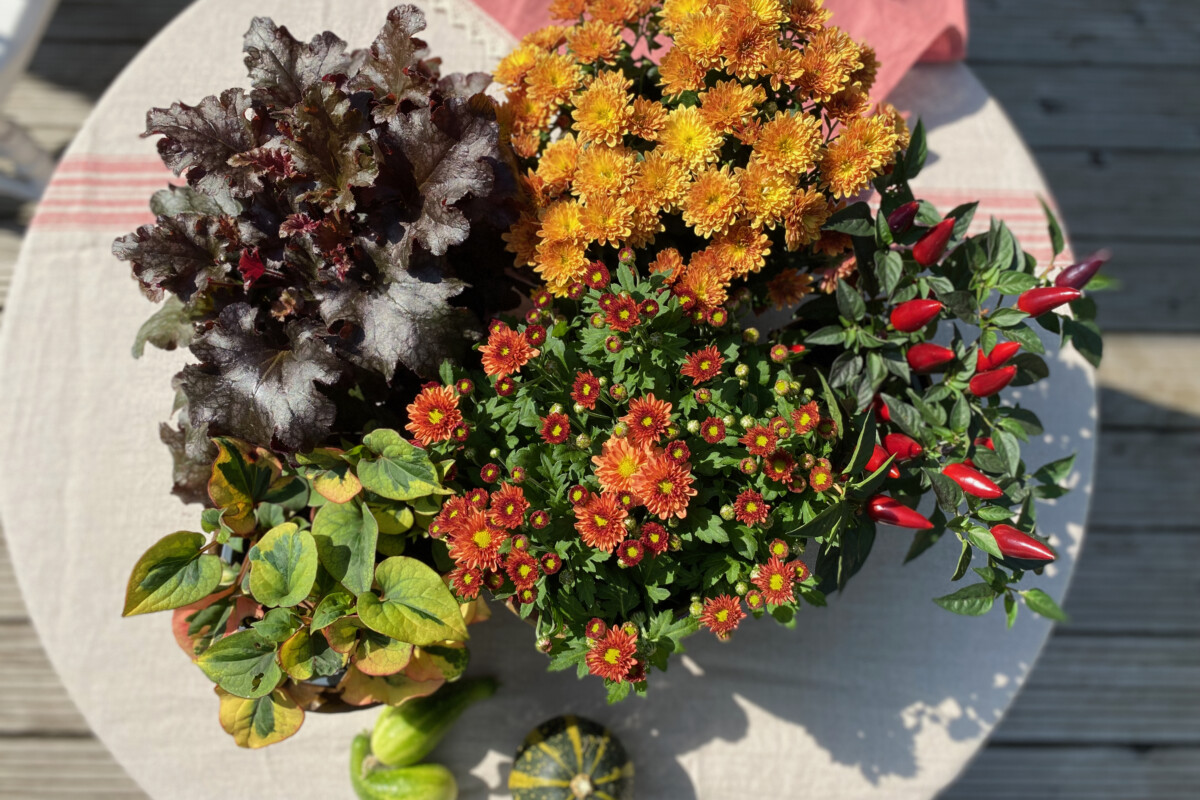
What should I plant in my fall window box?
In my article on planting a late spring/early summer container, I talked about having a general theme or goal in mind before you go plant shopping. For my fall flower arrangements, I knew I wanted something warm and moody, very fall-like, very Gilmore Girls-aesthetic. I was dead set on buying coral bells (Heuchera), chrysanthemums and coleus. And maybe something silvery.
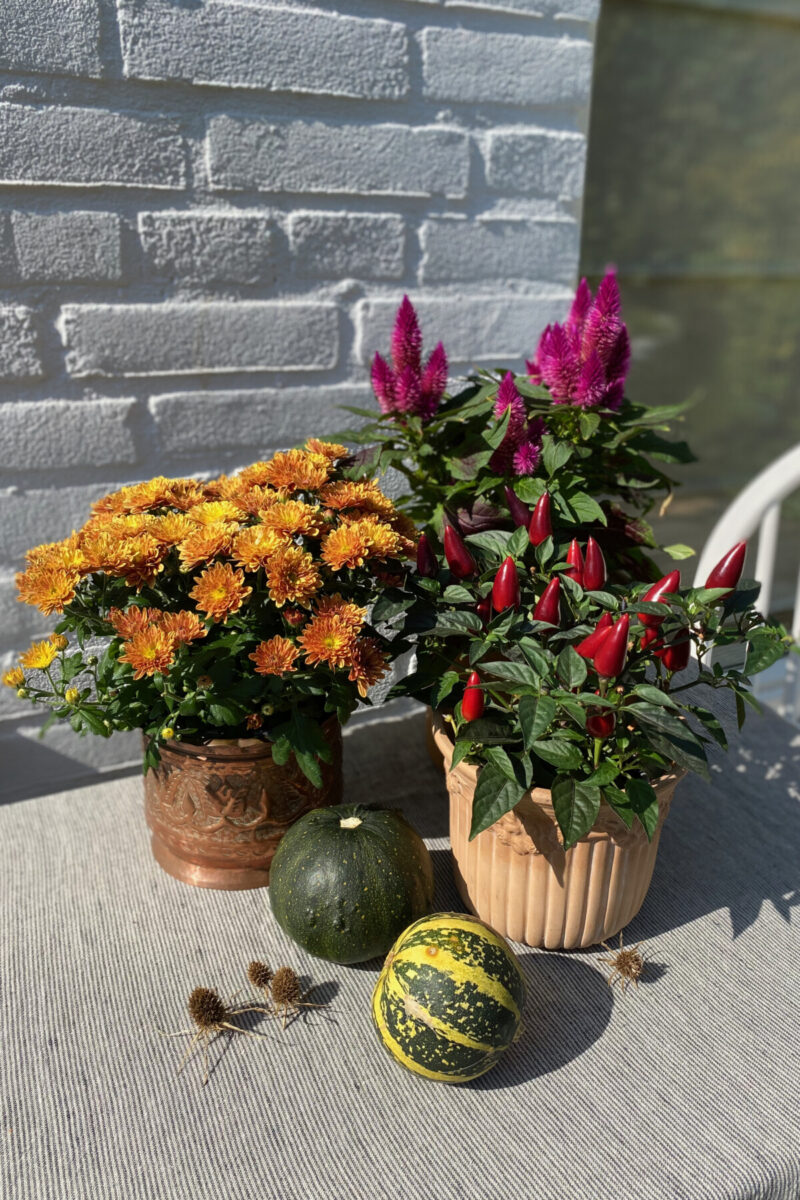
At the same time, I also wanted something cheerful that would compensate for the diminishing flower coverage in my garden come late September. I wanted to capture the transition from summer to fall without fully letting go of the brightness of summer. I didn’t know exactly what plants I wanted for this theme, but I knew one of them had to be a fuchsia-colored Celosia.
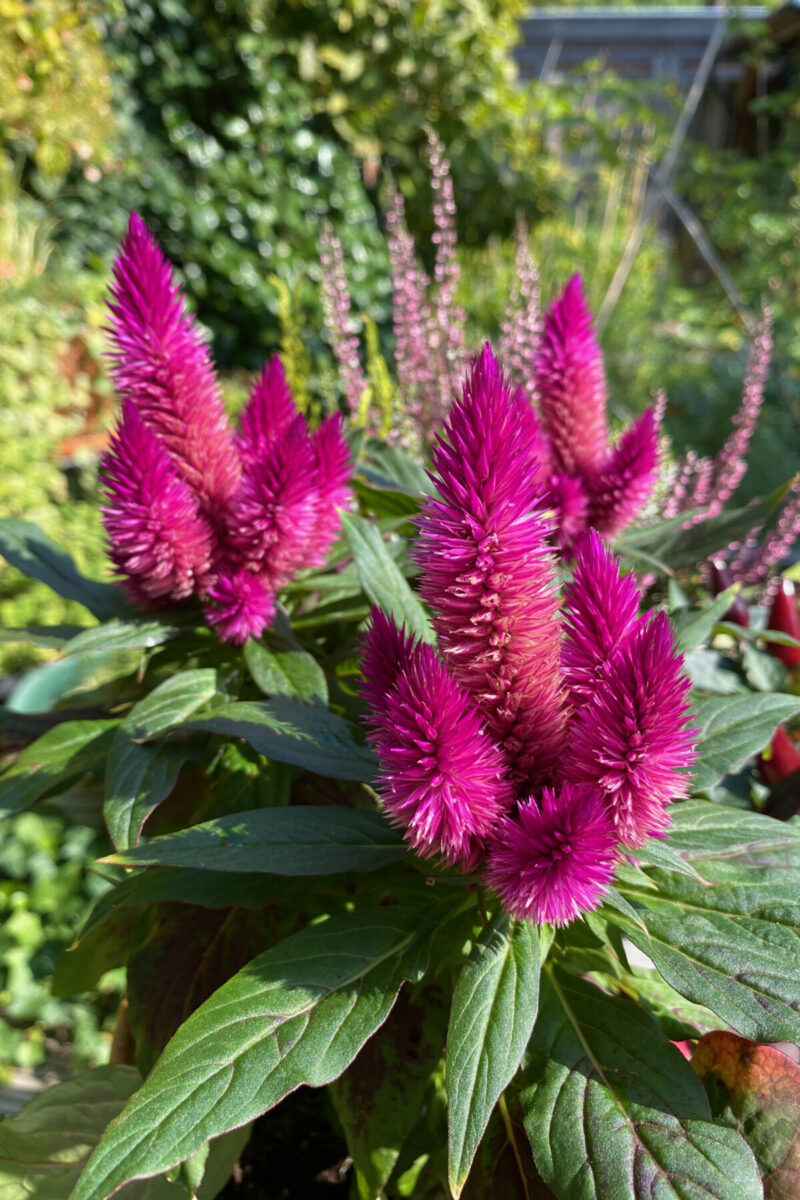
Since ‘cheerful’ and ‘moody’ are themes that don’t exactly mesh, style-wise, I decided that rather than create two identical and symmetric fall window boxes, I would flex my creative muscles and create two different designs. The window boxes are small enough for the designs to stand out on their own, without looking cluttered next to each other.
The trick with choosing the right plants for my fall window boxes
Challenge #1: Buying plants in season.
The challenge with aiming to create such different fall container designs was finding the right plants. I spent the better part of a Saturday afternoon browsing my local garden center like it was going out of business. (It wasn’t.)
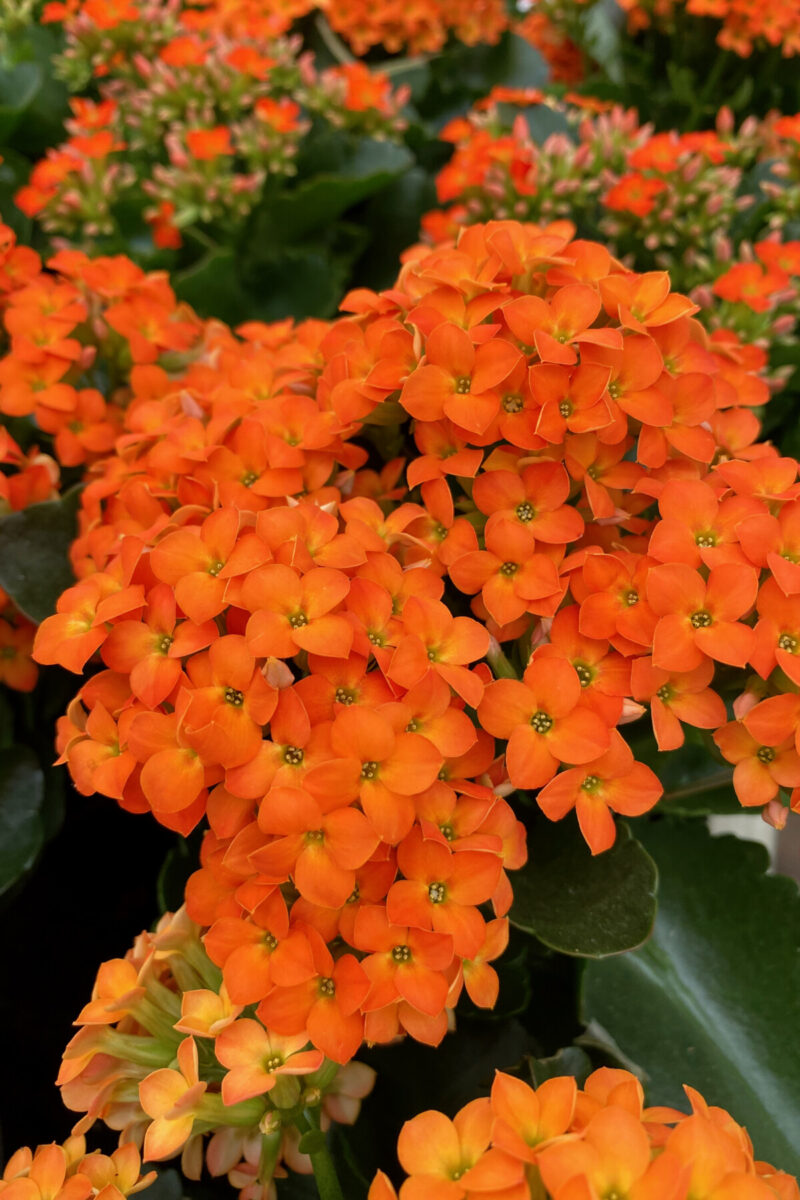
The problem wasn’t knowing what to choose, but choosing plants that would last past September. It’s a common issue to have when you go plant shopping close to the change of seasons. I saw some stunning nasturtiums and kalanchoes in bloom, but I knew that nasturtiums were on their way out and kalanchoe wouldn’t fare well in the cold weather that’s yet to come.
Challenge #2: Deciding which fall plants go well together.
The other challenge was choosing plant combinations that go well together. I was after colorful flowers and interesting foliage (preferably also colorful). I wanted a combination of annuals and perennials. And I definitely wanted mums.
So as we were slowly advancing through the garden center, I was grouping different plants in the shopping cart to see what went well together. Sometimes, you can just tell what doesn’t look good together, but that’s always very subjective. Always trust your instinct and your own taste if you think something clashes too much.
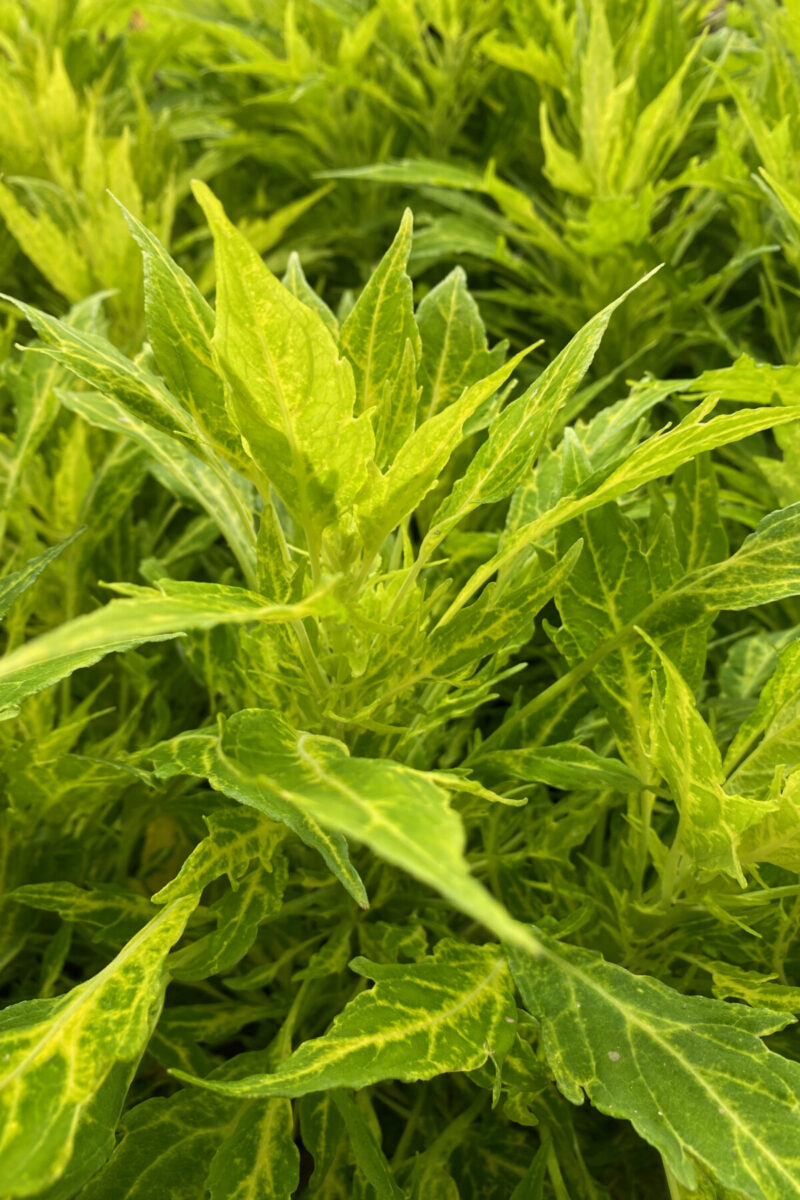
For me, that meant I had to abandon the idea of getting a coleus for my fall container arrangements. The ones they had for sale at the garden center were way too bright – almost lime-colored – even for my bright container idea.
Challenge #3: Best-laid plan(t)s.
Ok, this one may just be me, my poor memory and my inclination to change my mind. Having too many ideas can be a double-edged sword. At the store, I had decided what fall plant combinations to buy, but I made the mistake of not documenting how I wanted to arrange them.
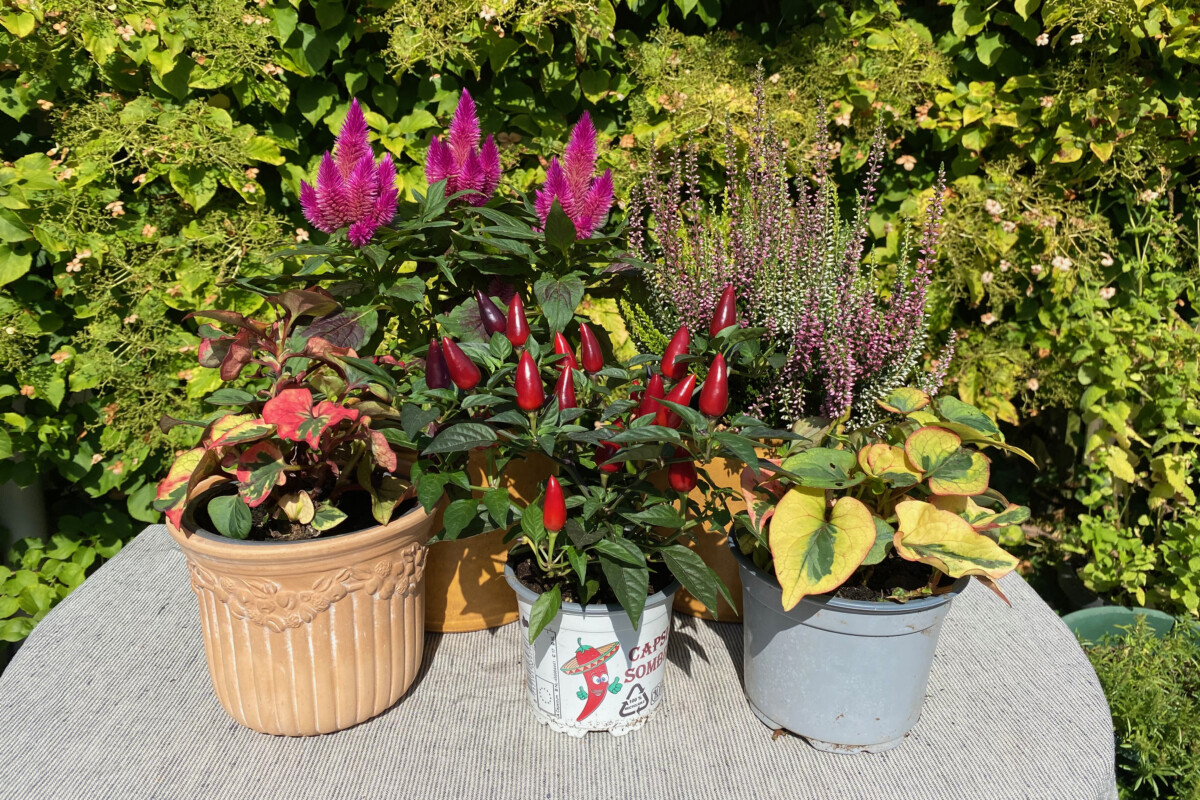
So once we unloaded them at home, I changed my mind a few more times before I settled on the final plant combos for my fall window boxes. It helped that between the time I got the plants and the time I planted them, I had a week to shuffle them around and see what works best.
If you’re not pressed for time, play around with the plant pots before you combine them into a larger arrangement.
The suspense is too much! What plants did you choose, Mickey?
Dear reader, here they are!
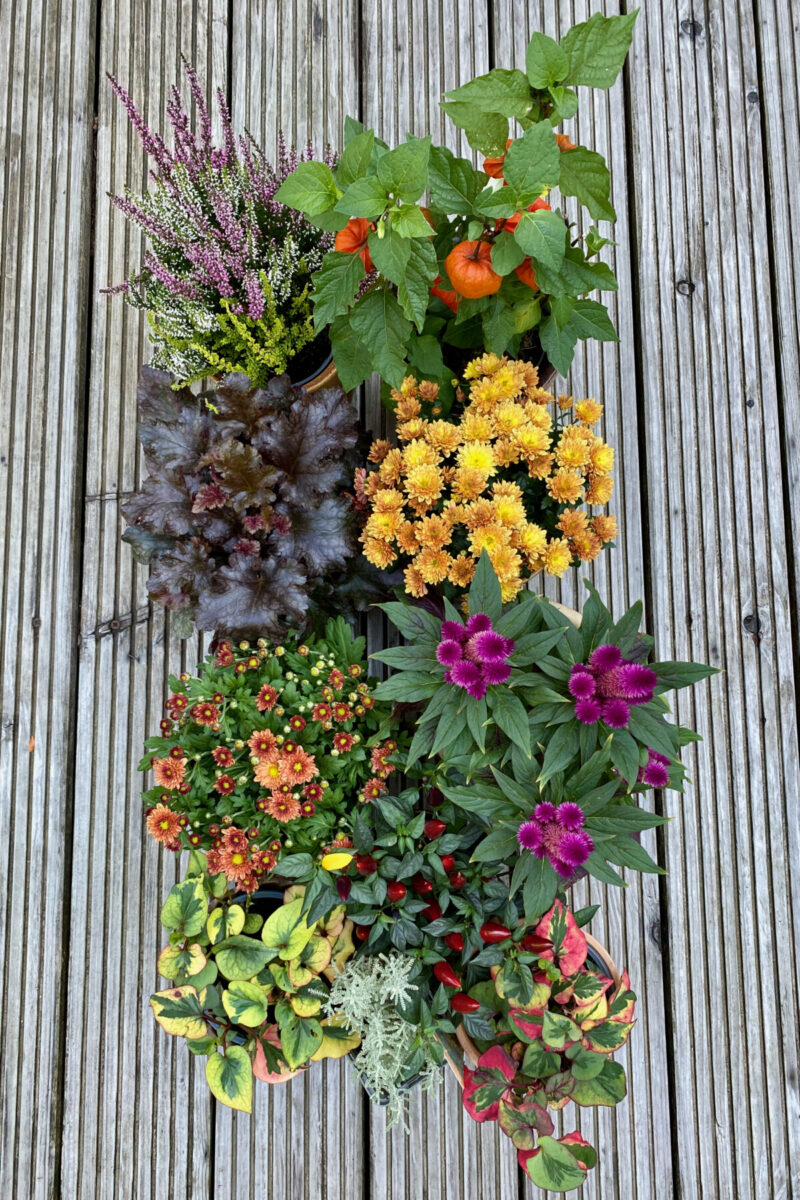
Moody and cozy fall window box plant combination
Chrysanthemums + coral bells + Chinese lanterns + santolina
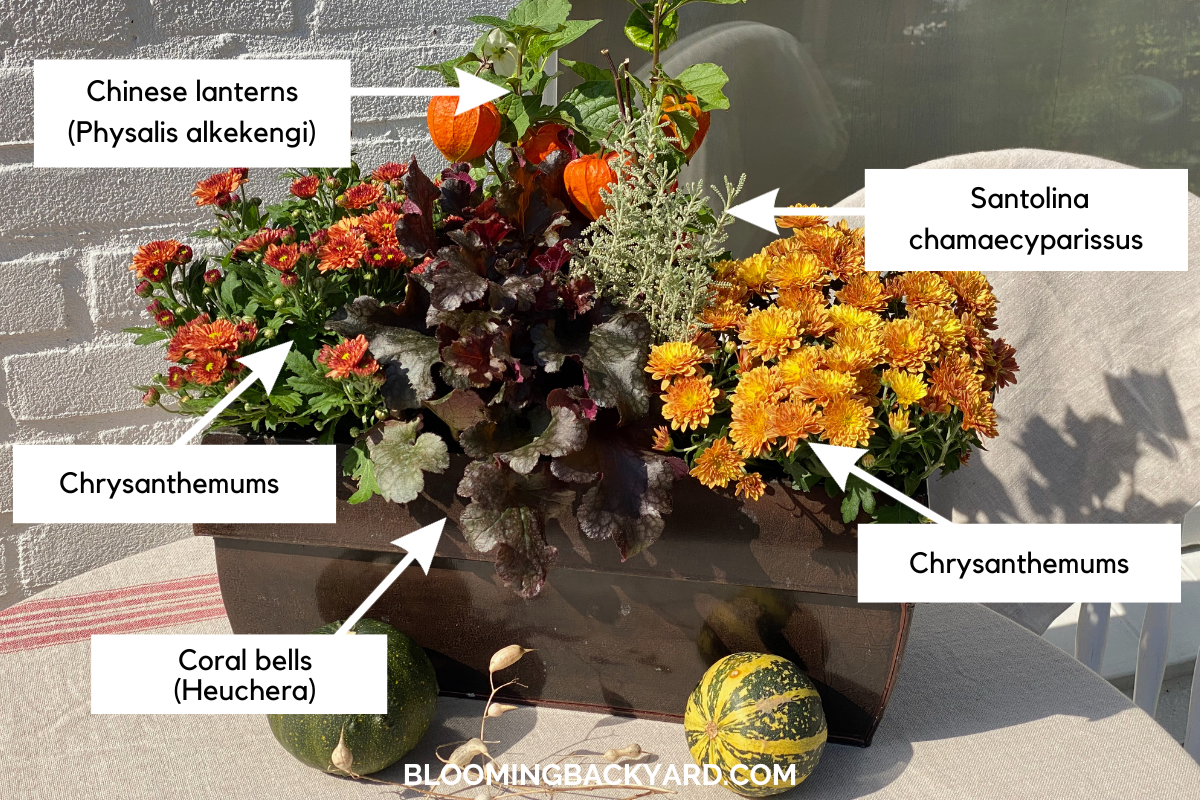
Chrysanthemums – For this container, I wanted to capture that quintessential fall feeling, and mums are an absolute must for that. There were a looooot of colors of mums at the garden center, so I went for warm (light orange) and rustic (burgundy orange).
As much as I love white flowers, I just don’t think white mums look good in a fall arrangement. I also chose two pots in different stages of bloom to extend the flowering display. I placed the mums on both sides of the window box to act as visual framing for the entire container.
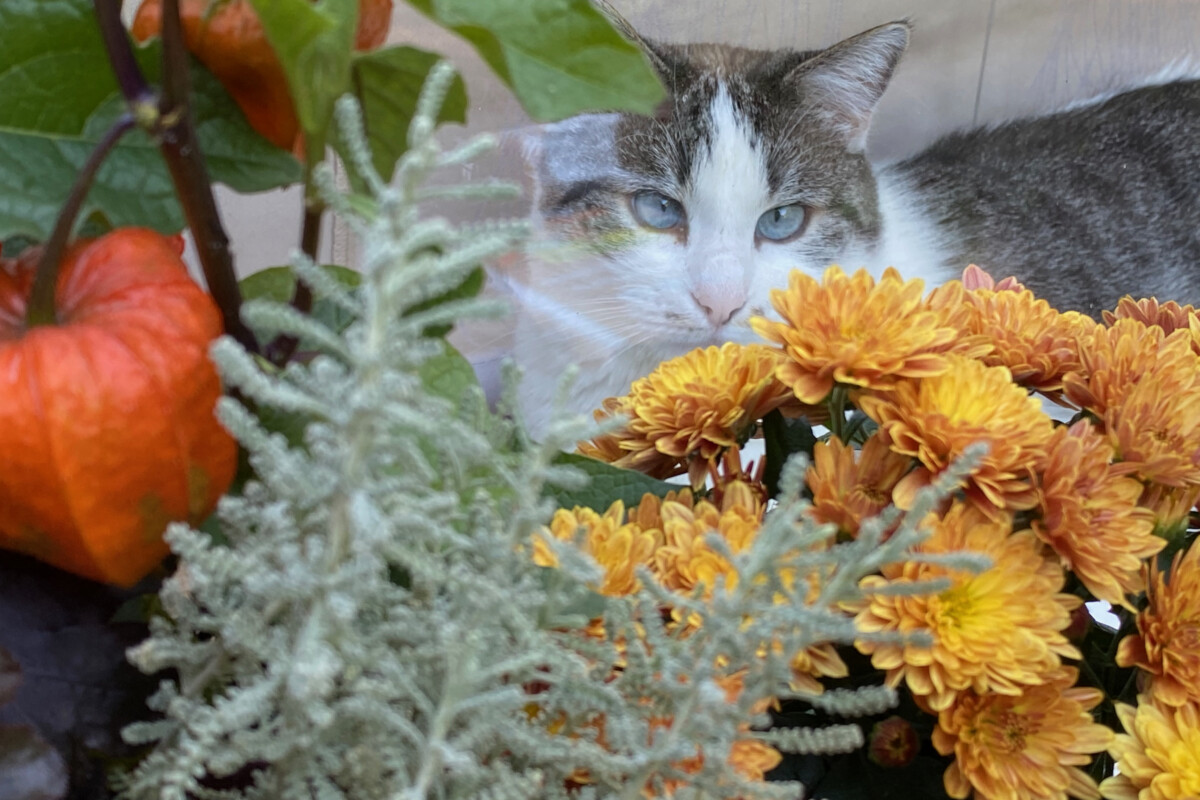
Coral bells (Heuchera) – This was one of the must-buy plants on my shopping list. Even though the popular name is derived from their bell-shaped flowers, the real attraction is the foliage. Heuchera leaves come in so many different colors, but since I wanted a moody and fall-like tone to mirror the change of colors on the trees, I opted for dark mauve.
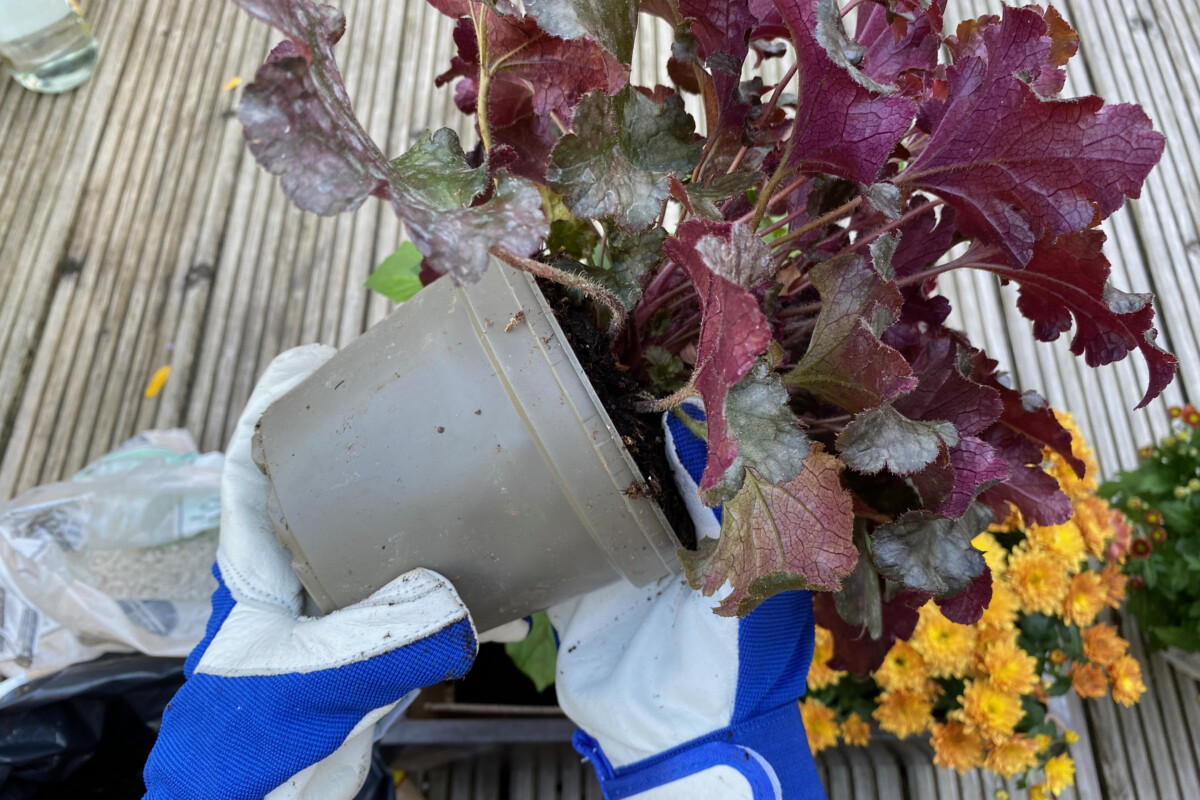
Chinese lanterns (Physalis alkekengi) is a plant that has so many popular names. Two important things to know about it are that it’s a herbaceous perennial AND it’s not edible. That’s the main reason why I don’t like using any popular name that contains the word “cherry.”
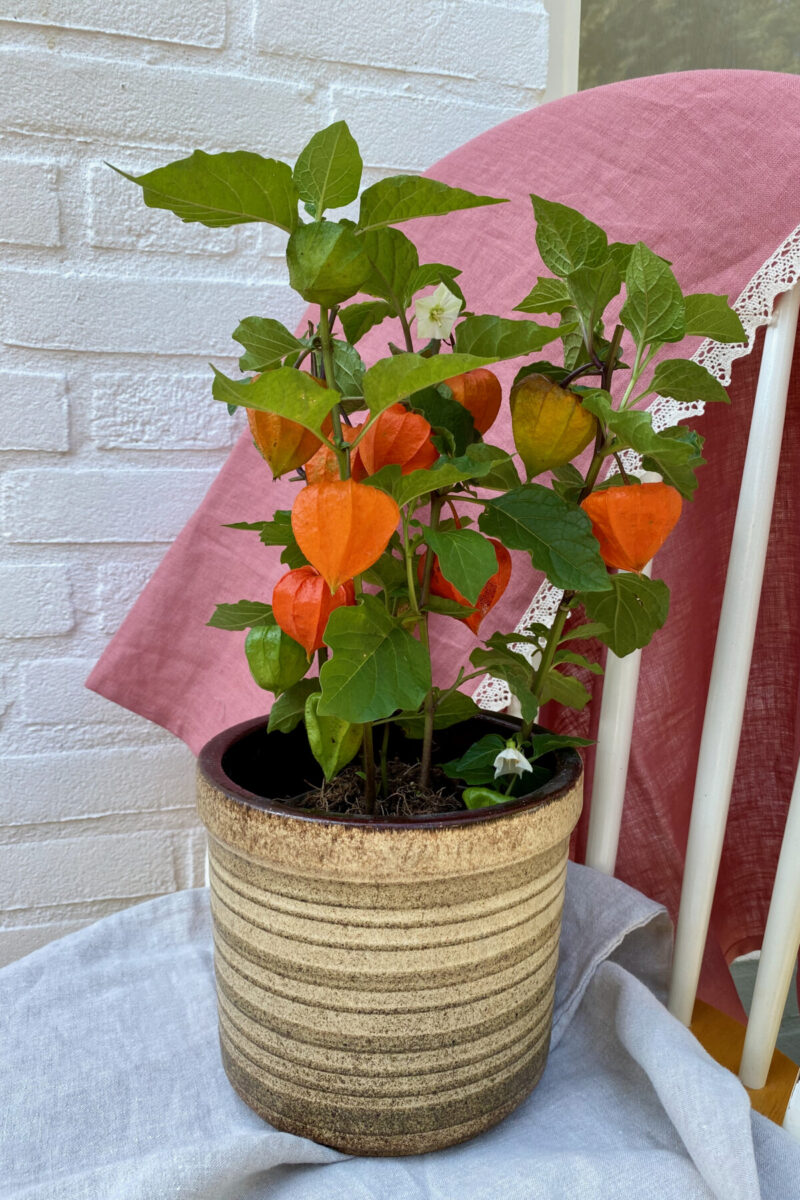
The flowers are very unassuming (small and white), but the fruit turns from green to bright orange to papery husk, which makes it a popular ornamental. I used it for the back of the container to add some height. Chinese lanterns can be a bit of a bully, so it’s best to keep them planted in containers.
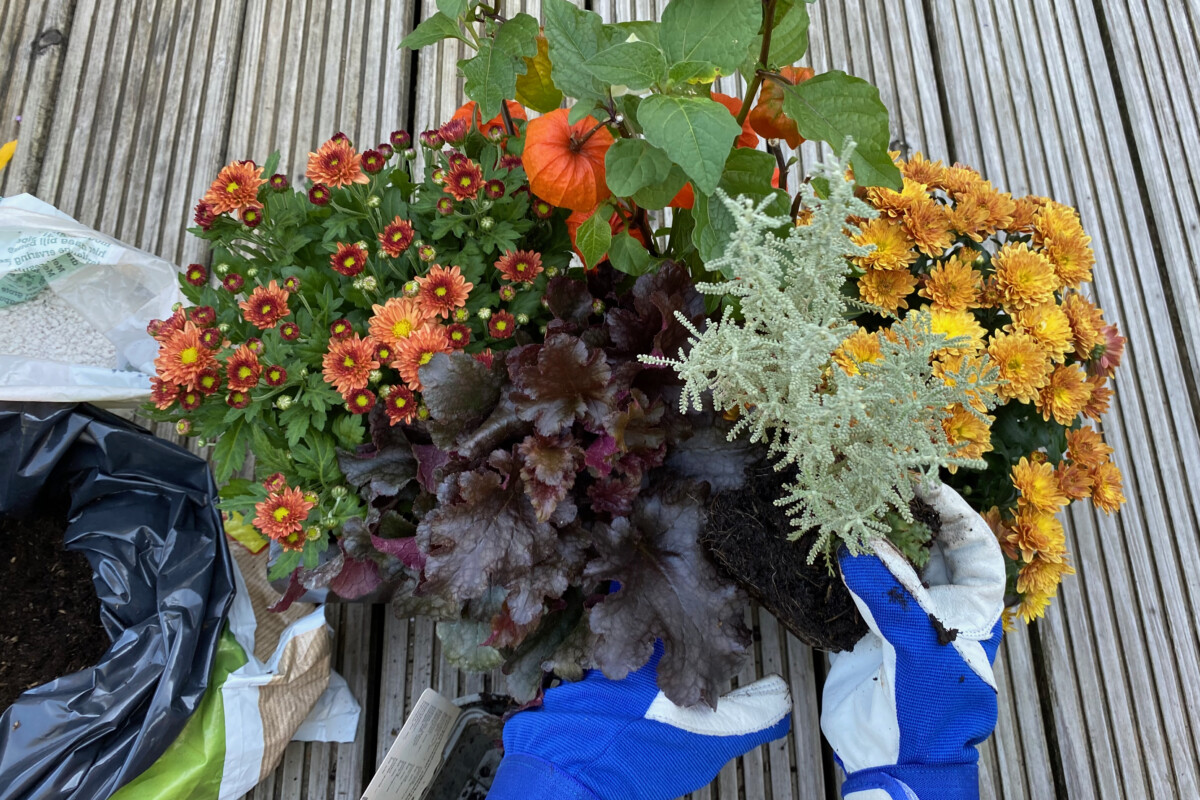
Santolina (Santolina chamaecyparissus) – This was one bit of improv that I’m still very happy about. I wanted a light touch of silver that would break up the warm palette. I could have chosen lavender, salvia or Russian sage. But I’m already growing all of these plants in the garden, so I opted for something new to me, a santolina starter plant.
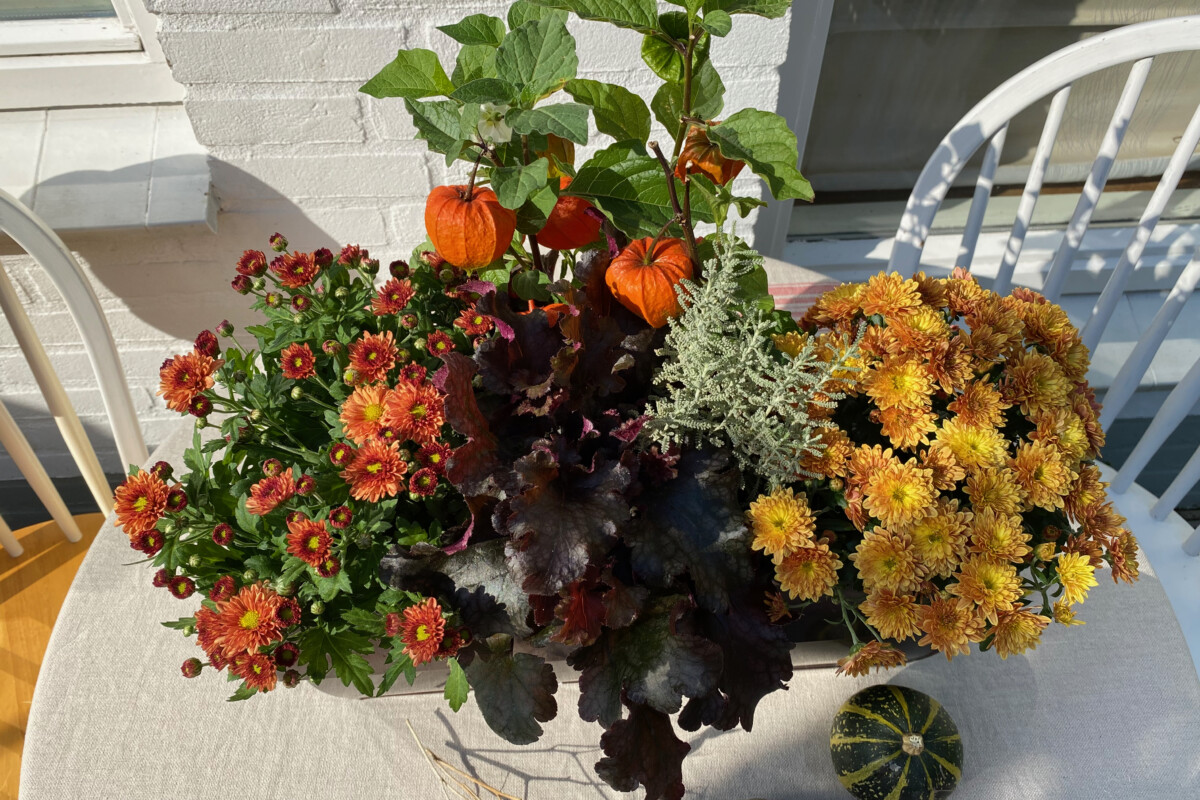
And here is the final result.
Bright and colorful plant combinations for fall window boxes
Celosia + heather + ornamental peppers + chameleon plant
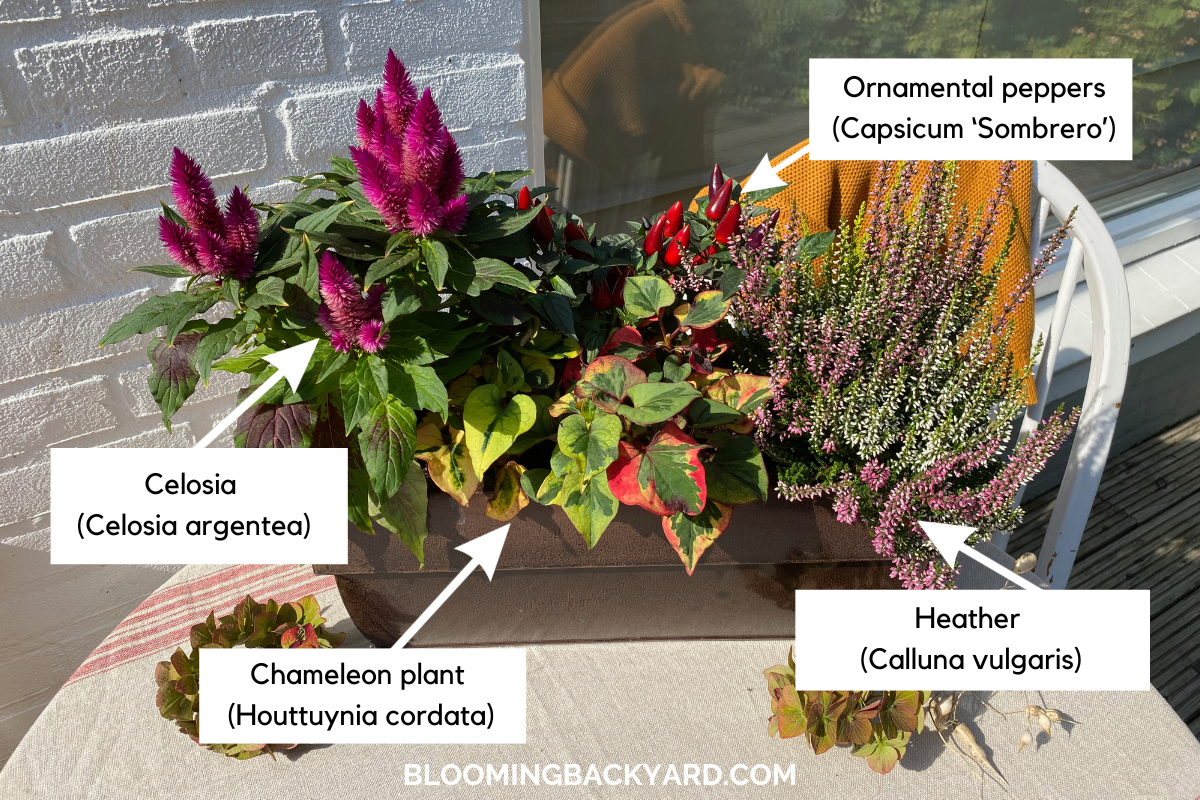
Celosia (Celosia argentea) was my one must-have plant for the radiant and cheerful fall container. It’s a super bright and rather cold fuchsia color. I didn’t choose it just for the flowers though. The leaves are incredibly pretty, with dark purple splotches on a bright green background. As a plus, pollinators absolutely flocked to it as soon as I brought it into the garden.
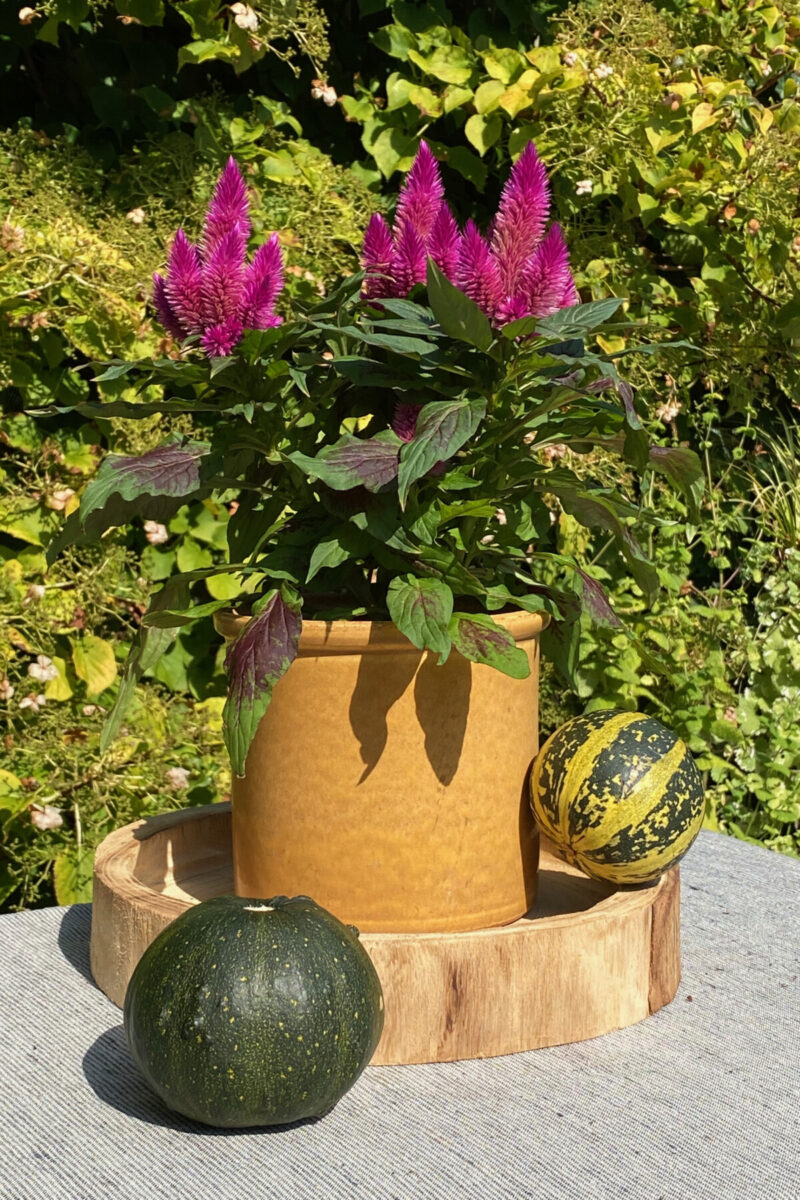
Heather (Calluna vulgaris) is a trooper. I bought a three-in-one color combo called ‘Trio Girls’. Its wispy flowers balance out the bright pop of color of the celosia at the other end of the planter. I managed to find a heather plant with a slight cascading effect over the edge of the planter.
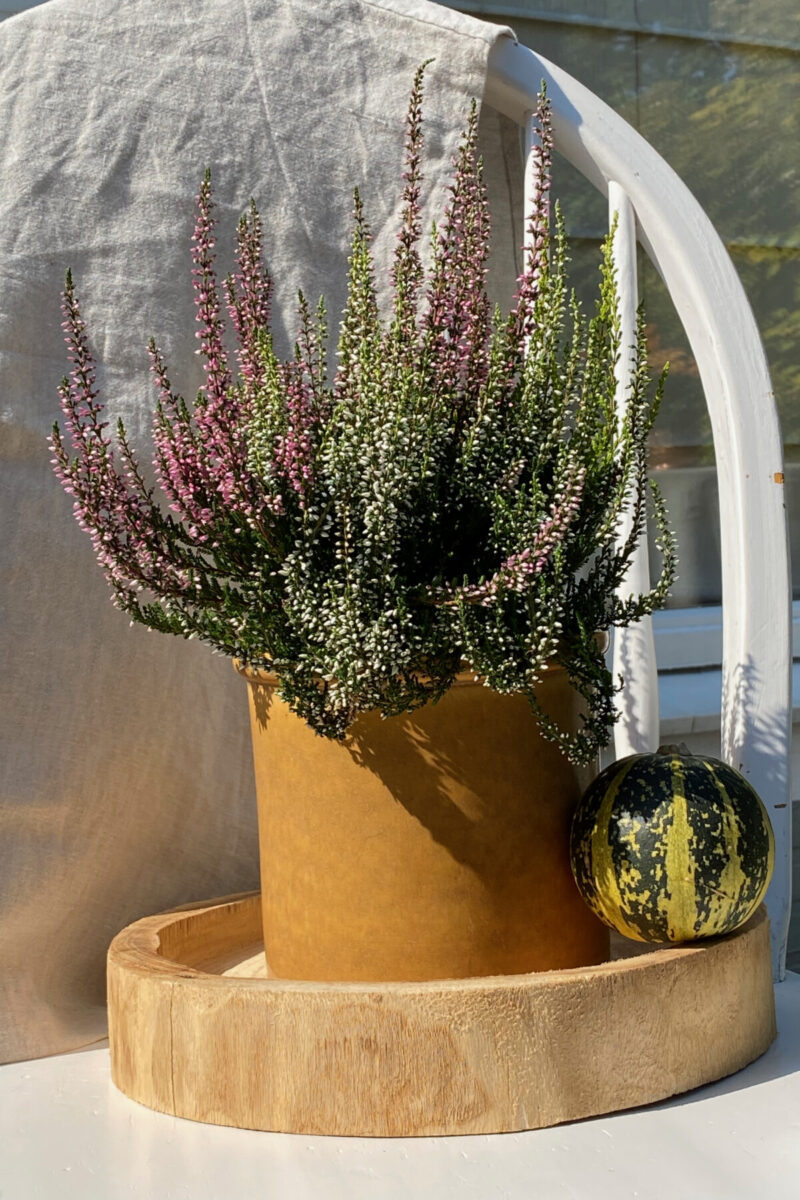
Ornamental peppers (Capsicum ‘Sombrero’) complete the skyline of this autumn container without taking center stage. I wanted another plant that was a bit jagged to contrast the round lines and velvety textures of the other container. These burgundy peppers are not edible, but their glossy fruit reminds me of candy corn, in shape if not in color.
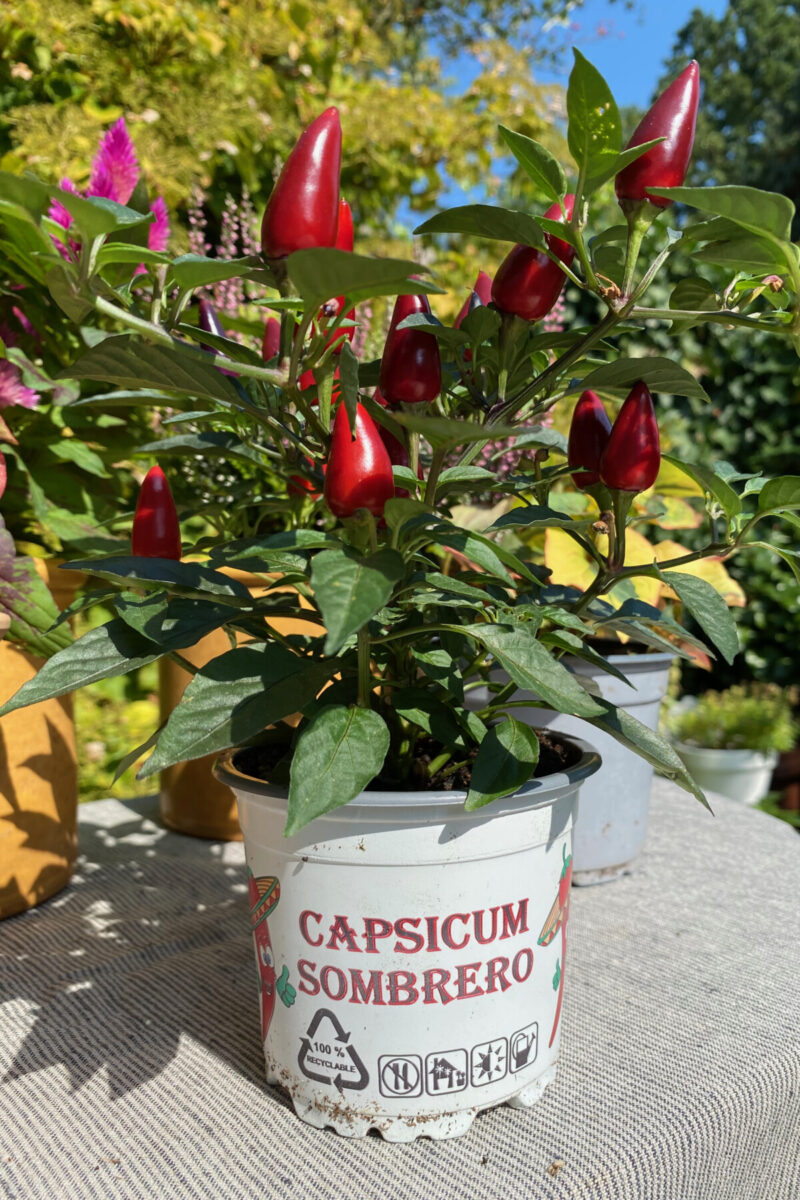
Chameleon plant (Houttuynia cordata) packs so much pizzazz for such a small plant. Again, I wanted something with interesting foliage to add to the middle of the container. But it would have to be the opposite of the dark heuchera. It would have to be bright and variegated, almost like a tropical version of fall colors.
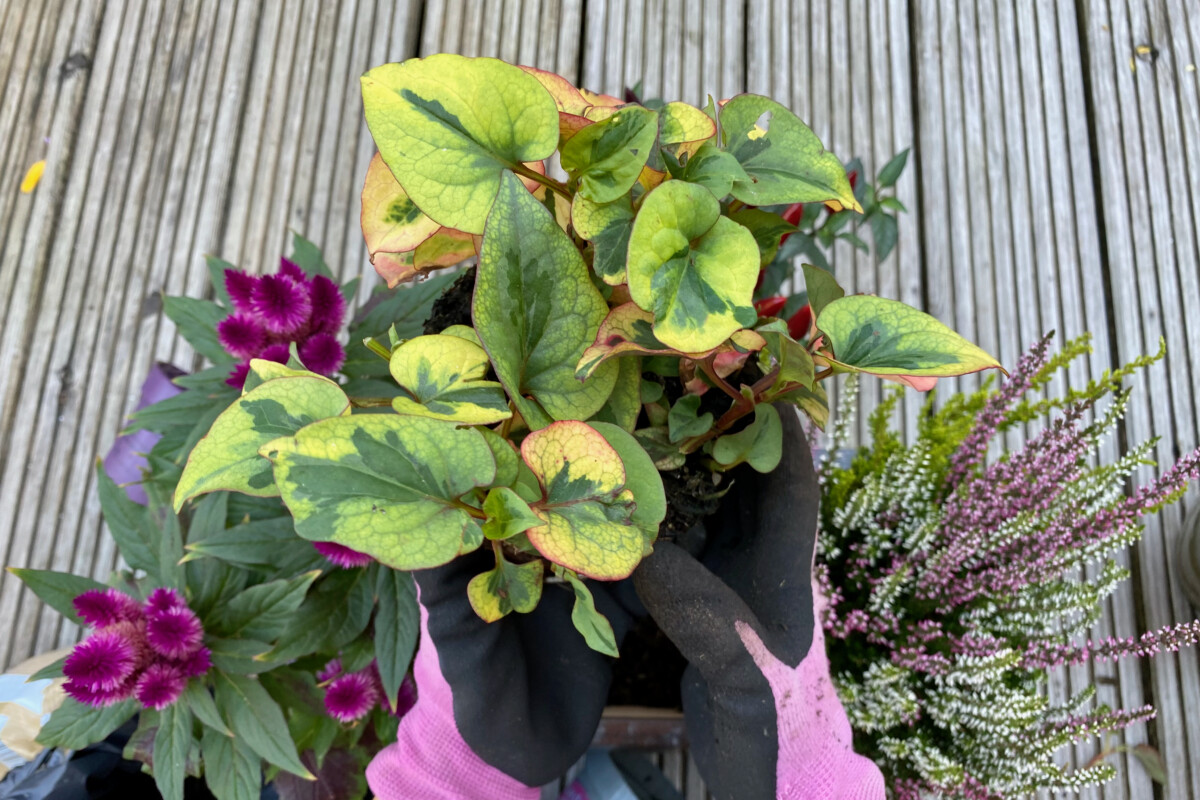
Just like the Chinese lantern plant, this chameleon plant spreads very fast via rhizomes. So if you do choose it for a fall container, don’t make the mistake of planting it in your garden later on. Keep it contained in a pot on solid ground and you shouldn’t have a problem.
How many plants should I plant in my fall container?
A quick note on planting density. I tend to underplant my containers. I don’t like to see plants squashed together and smothering each other out, so I don’t usually cram too many plants together in the same pot.
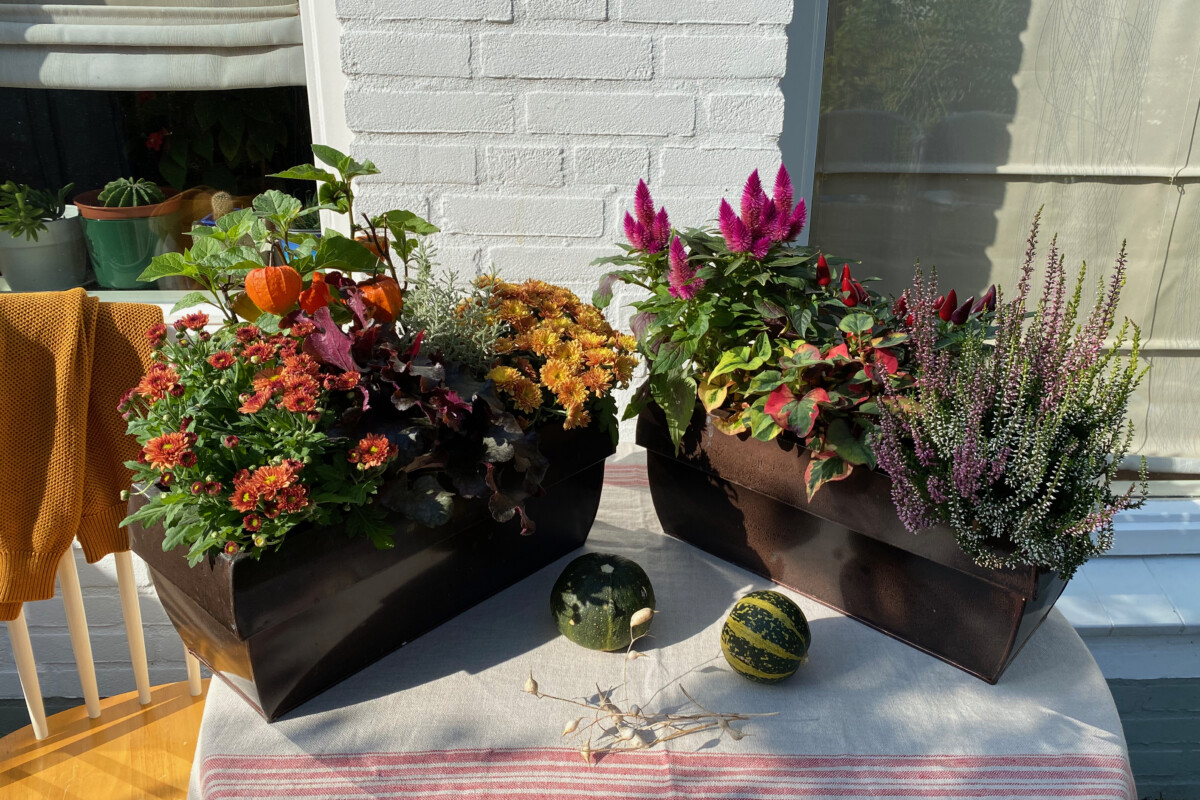
However, fall containers are the exception to this rule. That’s because in this season, the plants won’t grow as fast as they do in spring and summer. As the days draw in and the temperatures dip, plants still grow, but at a much slower pace. So while the number of plants depends on the size of the container, don’t be afraid to overplant a bit in the fall, especially if you already have a plan in place for what to do with the plants once winter rolls around. (More on this below.)
How can I reuse container plants?
Let’s talk a bit about the afterlife of our fall containers. When I design a container garden and buy or propagate the plants for it, I always think of their post-container life. I think that makes perfect sense. As gardeners, we are inherently averse to waste. We don’t like wasting plants or wasting space. From a garden budgeting perspective, it makes perfect sense too. If I can get a plant to do double duty, I will.
So when I’m choosing what to plant in my fall pots, I’m also thinking about what I’ll do with the plants at the end of fall. Here is my plan for these plants:
The chameleon plant and the physalis are sturdy perennials, but they are too aggressive to let loose in the garden. They will share a very large container – the one I was bulking up with old potting soil in this post – and keep each other in check. They both put out dainty white flowers in spring, so I have no doubt they’ll look very cute planted together.
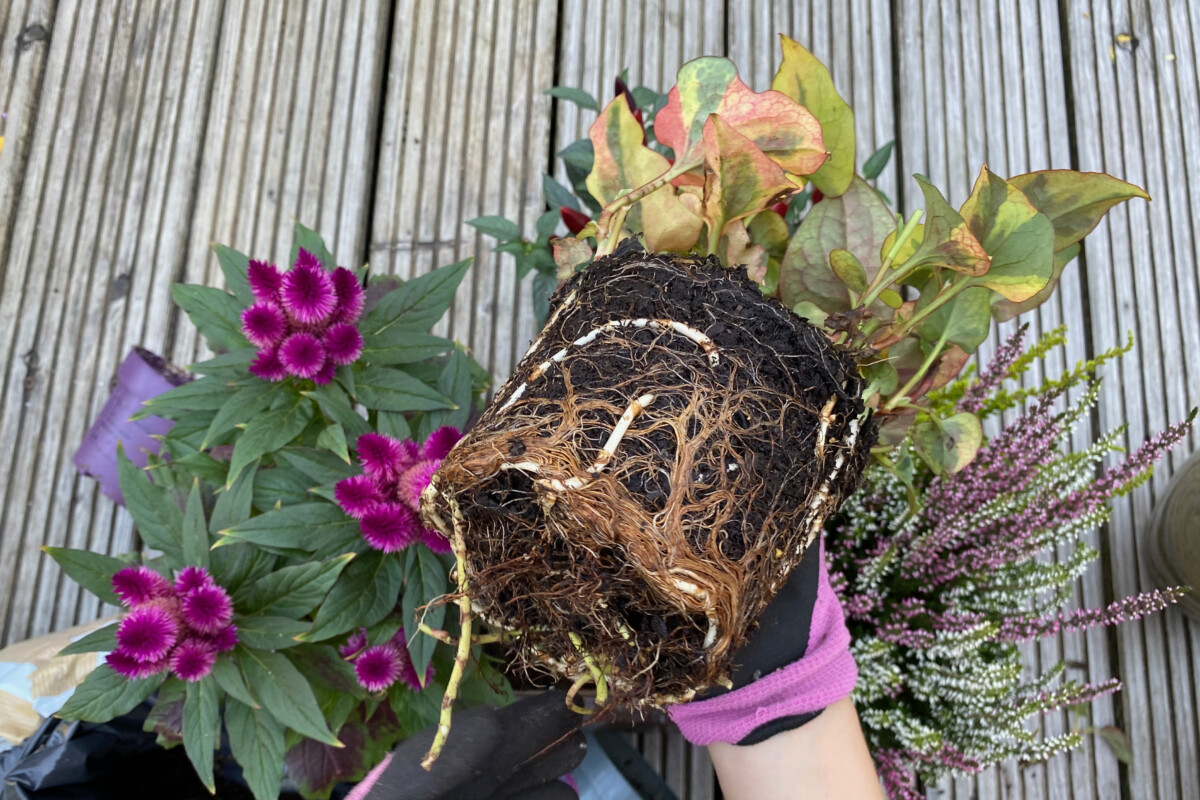
The heuchera and the santolina are also perennials. I will transplant them in the garden, right next to my Russian sage. The color combination (silver, yellow and black) should look stunning when the plants mature and fill up.
The two chrysanthemums will overwinter in another container together. I have successfully overwintered chrysanthemums for a few years and had them bloom again the following fall.
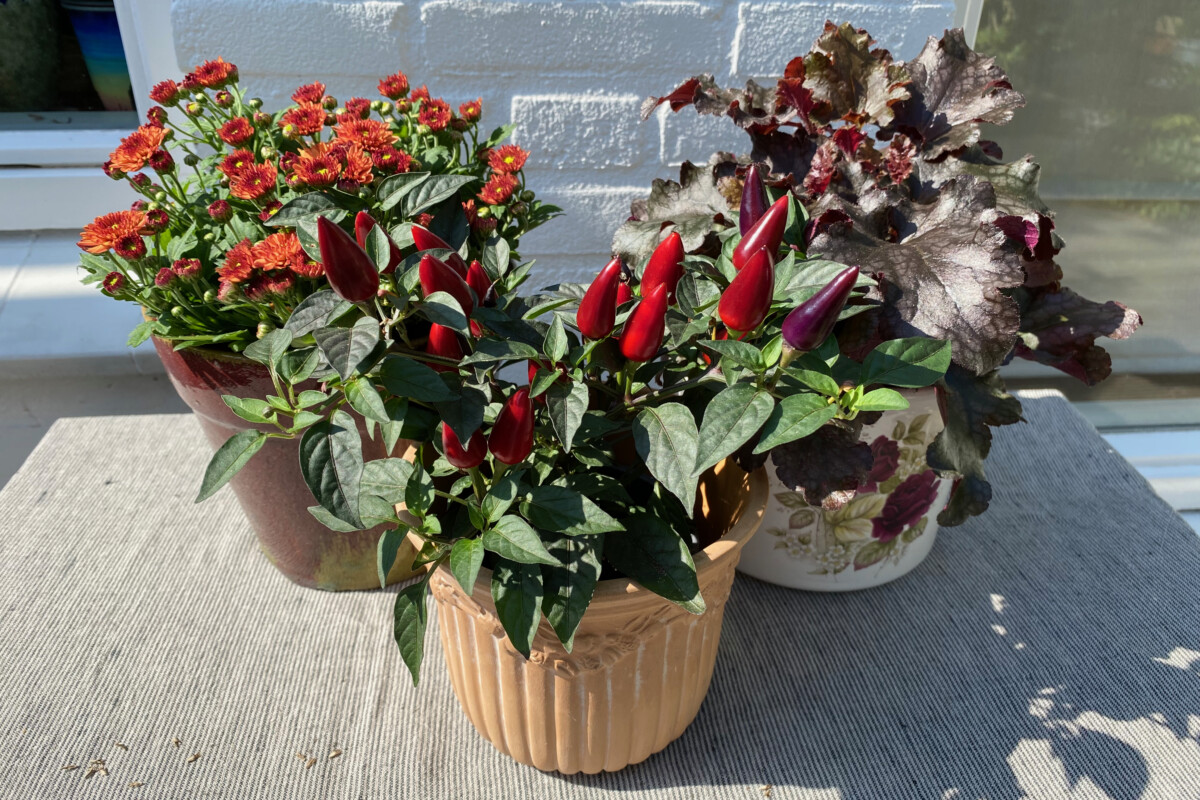
Capsicum ‘Sombrero’ is definitely an annual, but a long-lasting one as long as it’s not subjected to frost. When I disassemble my fall containers, I will take this one inside and use it as a centerpiece on our dining table. I wouldn’t recommend this if you have small kids in the house who might be tempted by the berry-like fruit. But in our house, it’s just two (mostly) responsible adults, so having a non-edible pepper plant indoors shouldn’t be a problem.
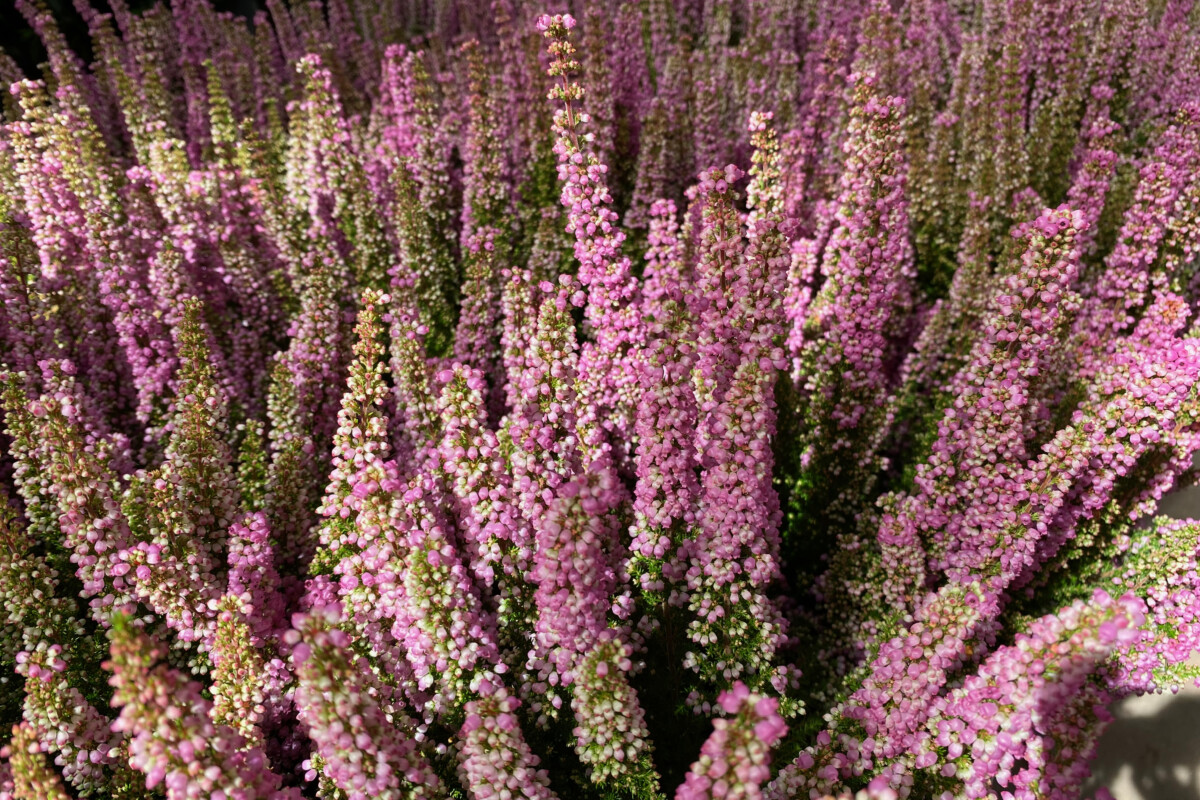
I have so many plans for the heather since it’s such a versatile and sturdy plant. Not only is it a perennial, but it’s an evergreen perennial, which honestly feels like hitting the plant jackpot. When I take apart my fall containers, I’ll add the heather to a winter container garden (yes, that’s a thing). Then I’ll either transplant it to my perennial border or give it its own roomier pot. This latter option will keep it available for other container arrangements in the future. Heather is rather slow growing and stays compact, so it’s the perfect puzzle piece to complete a potted flower display.
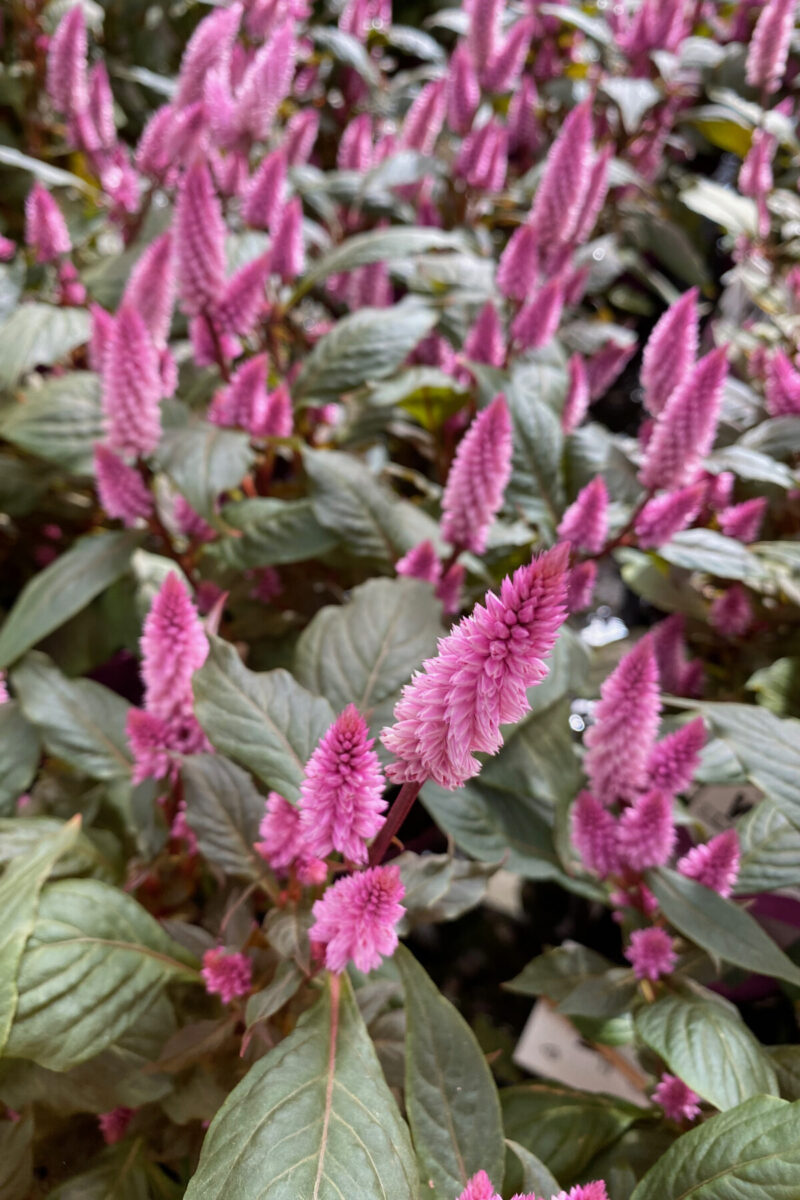
Celosia argentea is an annual in my gardening zone. If you live in USDA zones 10-11 (or equivalent), you can also grow it as a perennial. It will survive warm winters, but I don’t think it will survive in my garden. Nevertheless, I still have a continuity plan. I will plant it in the garden and allow it to self-seed at the end of fall. I’ll also collect some of the seeds and replant them in spring.
To get even more inspiration for what to plant in seasonal containers, have a look at this article I wrote for Blooming Backyard.

